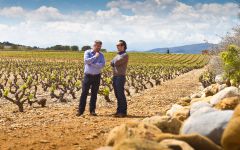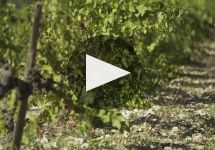Hecht & Bannier Minervois 2011
-
Wine
Spectator




Product Details
Your Rating
Somm Note
Winemaker Notes
Professional Ratings
-
Wine Spectator
Suave and rich, with effusively fruity flavors of blackberry, dark plum, blueberry and spice. Features medium-grained tannins, with some graphite and mineral notes. Finishes with bittersweet chocolate accents. Drink now through 2018. 575 cases imported.
Other Vintages
2015-
Wine
Spectator
-
Wine
Spectator
-
Robert
Parker
-
Wine
Spectator
-
Robert
Parker
-
Robert
Parker
-
Robert
Parker








Formed in 2002, Hecht et Bannier produces wines that are reference points for the Roussillon, Languedoc and Provence. Founders Gregory Hecht and François Bannier note: “To conserve the typical Mediterranean strength in our wines while preserving balance and crispness, this is our mantra for all the appellations we produce.” This cutting-edge firm is one of the south’s most exciting projects in recent memory, and promises to be a formidable player with dramatic impact in the region.
Hecht & Bannier is at the forefront of a revolution in quality in the diverse appellations of Roussillon, Languedoc and Provence. From Côtes du Roussillon Villages to Languedoc Red to Côtes de Provence Rosé, each of Hecht & Bannier’s wines is typically based on 5-10 different parcels found to be of exceptional quality. These blends are then vinified and bottled to best represent each appellation in the range.
All Hecht & Bannier crus are aged for two years in large, traditional “Demi Muids” (600L) wood barrels that insure preservation of fruit quality and impart “resistance” to the wines allowing them to age well. A portion of each wine is aged in neutral concrete vats to focus the expression of fruit and appellation.
The Wine Advocate June 30th, 2011, noted: “Gregory Hecht and François Bannier’s are living up to the challenge they set themselves, namely to render, as négociants…wines that can stand comparison with those of each respective appellation’s top estates.”

With hundreds of red grape varieties to choose from, winemakers have the freedom to create a virtually endless assortment of blended red wines. In many European regions, strict laws are in place determining the set of varieties that may be used, but in the New World, experimentation is permitted and encouraged resulting in a wide variety of red wine styles. Blending can be utilized to enhance balance or create complexity, lending different layers of flavors and aromas. For example, a red wine blend variety that creates a fruity and full-bodied wine would do well combined with one that is naturally high in acidity and tannins. Sometimes small amounts of a particular variety are added to boost color or aromatics. Blending can take place before or after fermentation, with the latter, more popular option giving more control to the winemaker over the final qualities of the wine.
How to Serve Red Wine
A common piece of advice is to serve red wine at “room temperature,” but this suggestion is imprecise. After all, room temperature in January is likely to be quite different than in August, even considering the possible effect of central heating and air conditioning systems. The proper temperature to aim for is 55° F to 60° F for lighter-bodied reds and 60° F to 65° F for fuller-bodied wines.
How Long Does Red Wine Last?
Once opened and re-corked, a bottle stored in a cool, dark environment (like your fridge) will stay fresh and nicely drinkable for a day or two. There are products available that can extend that period by a couple of days. As for unopened bottles, optimal storage means keeping them on their sides in a moderately humid environment at about 57° F. Red wines stored in this manner will stay good – and possibly improve – for anywhere from one year to multiple decades. Assessing how long to hold on to a bottle is a complicated science. If you are planning long-term storage of your reds, seek the advice of a wine professional.

Recognized for its concentrated and sultry reds made predominantly of Carignan, Grenache and Syrah, this western Languedoc appellation is also famous for the charming and delicate fortified Vin Doux Naturel called Muscat de St. Jean de Minervois. The dry rosé and white wines of Minervois are also worth seeking out.
